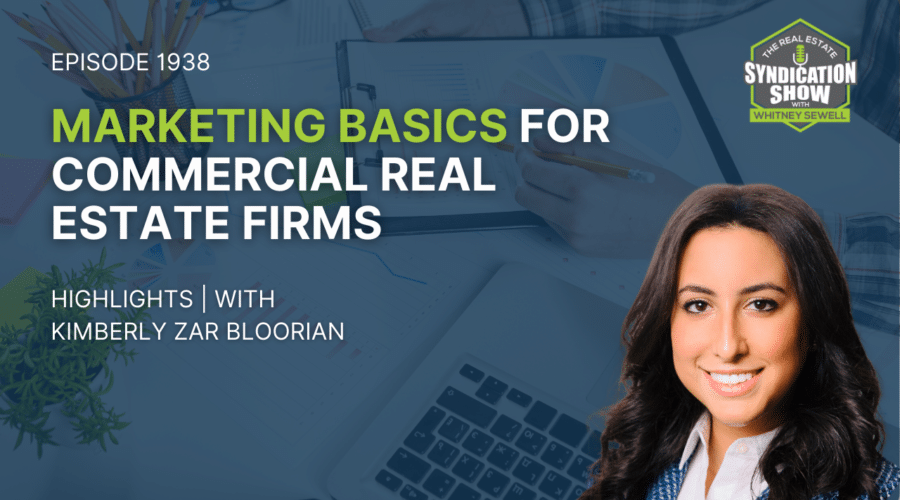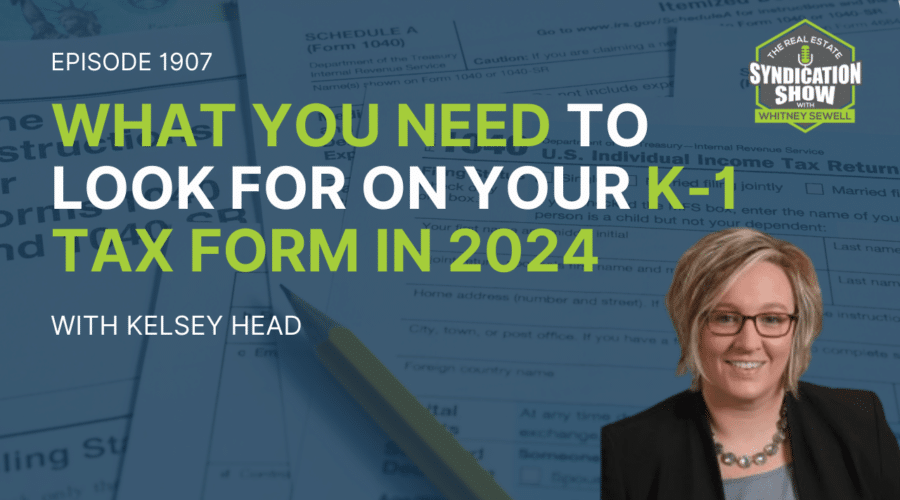Can I roll 1031 exchange funds into syndication investments? That’s a question I often get asked by investors. It’s a popular topic in online real estate investing forums too. No other tax code generates as much buzz and excitement as Section 1031 of the Internal Revenue Code. It’s easy to see why, as it holds the promise of creating a wealth-building legacy that will stay with you and your heirs for many generations. It’s a legitimate method used by savvy investors to continue to grow their investments and defer taxes by rolling over the gain from one real estate investment to another and another. If done correctly, 1031 exchanges will allow an investor to defer capital gains until the time of death, at which point the property is passed on to the heirs.
But, how exactly do 1031 exchanges fit into syndications? My recent conversation with Alex Shandrovsky and Michael Brady of Madison 1031, a national qualified intermediary for tax-deferred exchanges, provides key answers. We discussed the strategy and the mechanics used to apply a 1031 exchange to syndication investing. We break down the challenges and complications of bringing a 1031 exchange into syndication and recommend strategies to hurdle these potential problems so you can 1031 your way to growing your portfolio. (Yes, it can be used as a verb in real estate parlance.)
If you’re a 1031 property owner and considering investing in syndications, and you want to learn how to use 1031 exchange funds, this article is for you. If you’re a syndicator considering 1031 investors and too overwhelmed by technical details, here’s a piece-by-piece look that could help. Want to listen to the full conversation? Please click here
What is a 1031 Exchange?
1031 Exchange refers to the IRS Section 1031 which permits investors to sell an investment real estate property and subsequently buy replacement “like-kind” property with little to no tax burden.
Alex used this analogy to illustrate the reason behind the 1031 Exchange IRS Code: The IRS is like Uncle Sam who invests with you at every single investment you make. And when you’re ready to sell the investment, and there has been appreciation, he’ll come to you and say, “Look, we did so well, it’s time for you to give me a percentage of that appreciation.” That percentage is the tax on your capital gains. Now, he says, “Wait a second, you did so well in the market that I really want you to stay and keep your money there. I’m going to give you this 1031 Exchange vehicle which will allow you to fully reinvest all the proceeds from the sale into another “like-kind” investment property and you don’t have to give me a percentage of that appreciation.”
The following is the typical process of the 1031 Exchange as outlined by the IRS.
- The Exchanger (the owner who would relinquish the property) contacts a Qualified Intermediary (such as Madison 1031) to get the 1031 process started.
- The Qualified Intermediary prepares the Exchanger’s 1031 Exchange documents and coordinates with the attorney, lender, Realtor and/or Closing Agent to prepare for the closing of the Relinquished Property.
- At closing, the Qualified Intermediary for the Exchanger — receives the proceeds from the sale of the Relinquished Property and places the 1031 Exchange funds into a secure, dual-signatory account.
- Within the next 45 days from the sale of the Relinquished Property, the Exchanger must identify the potential Replacement Property/ies and begin negotiations to purchase.
- The Exchanger then decides on a specific Replacement Property and agrees to terms with the seller. This information is then provided to the Exchanger’s attorney and to Qualified Intermediary. Closing must be scheduled no later than 180 days after the date of sale of the Relinquished Property.
- At closing, the Qualified Intermediary transfers the 1031 Exchange funds to the seller of the Replacement Property, and the Exchanger then takes title ownership of the Replacement Property.
With the 1031 exchange, the capital gains tax is being delayed and you will not be compelled to pay it. This tax savings will allow you to continue to make money, grow your wealth, and create financial freedom for many generations.
Types of Investors Who Would Want a 1031 Exchange
Typically, investors who would want a 1031 exchange have two objectives apart from the tax-deferral benefit, Alex explains. One, the investor has no intention of taking the cash from the sale of the property. Two, the investor is looking to reinvest all the proceeds of the sale into the market and is planning to stay in the market for the long term. Essentially, 1031 investors are long-term, forward-thinking, seasoned investors who, most likely, will continue doing exchanges until the point of death. At that point, their holdings will go to the successor. All the while, 1031 investors enjoy support from the government – whose goal is to push the market forward.
From a financing perspective, Michael explains a 1031 Exchange as a term-free, interest-free loan from various levels of the government, including the federal government as well as the various states and some cities that impose taxes on capital gains. This allows the investor to go out and buy a bigger, more profitable property using 1031 funding.
Can I use a 1031 Exchange to invest in multifamily syndication?
The answer is yes.
The common misconception that you cannot do a 1031 exchange into syndication stems from the fact that when you invest in multifamily real estate syndication, you are purchasing shares of an entity that owns the property, not the property itself, and that this would not amount to a property swap. With the typical structure of a syndicated group involving General Partners and Limited Partners as owners of the entity, it becomes tricky to figure out how and where a 1031 investor would be positioned in the structure. The 1031 investor is neither a General or Managing Partner (who find the property, close the contract, and execute the business plan) nor a Limited Partner (who invests cash into the project to cover down payment costs, working capital, and other soft costs.)
So, how does a 1031 investor fit into a syndication structure?
Michael advises that one way to facilitate 1031 Exchanges into a syndication is through a structure called Tenancy-In-Common (TIC). The 1031 investor will not be a member of the ownership entity, the limited liability company of the partnership, but will be a tenant-in-common (TIC) that would have a separate deeded interest in the project along with the syndicated entity. As a tenant-in-common (TIC), the investor is taking direct title to the syndicated property, which is one of the key requirements of a legitimate 1031 exchange.
The TIC is separate from the general partnership and is its own entity with its own interest or ownership of the property.
As a separate entity from the general partnership and in being under the IRS Revenue Procedure 2002-22, it’s important that the TIC’s returns match their interest in the property, says Michael. He adds as an example: if they have 10% investment, they would get a 10% return. They have joint ownership of the property with equal control and are entitled to management fees just like the managing partners.
I know at this point, the TIC may sound challenging and unsavory for a syndication sponsor or general partner. However, we don’t want to give an outright “no” to a potential 1031 investor either. Let’s explore the TIC further and figure out some ways around it.
Some Challenges for the Syndicator and their Workarounds
Challenge 1: The TIC investor has to receive returns equal to their investment.
This may not be a great arrangement for the syndicator where you would have some preferred returns, some waterfalls, and some funds for the syndicator -however, initially, this is the process to bring them into the syndication. “But, you might want to be stuck in that structure for some time especially if there’s a substantial 1031 investment,” advises Michael, adding that the syndicator may allow this setup to work for a limited period – say, two years.
“I will try and get the accountants involved, to see if there are other creative things that could be done about the returns but that’s essentially the structure and should be for a limited period of time. Two years is not a magic number but seems to be a relatively good number in terms of the tax codes for other areas,” recommends Michael, pointing out that at some point down the road, the TIC investor can contribute their ownership to the syndicate and become part of the family essentially. The syndicator just has to make sure the deal is structured appropriately.
Challenge 2: In a TIC structure, there are some decisions that have to be made by the property owners that should be by unanimous consent.
Alex cites the following example: “A TIC investor could hold up the sale of the property at least to the extent that they refuse to sell their interest. If the TIC is 1% owner of the property, the TIC’s agreement to the sale is equally important as all the others because the sale has to be unanimous.”
“Even if the 99% is free to sell their 99% and leave the 1% in there, it affects the marketability of the property if you have particularly recalcitrant owner”, adds Michael.
He admits that this becomes a problem down the line when a TIC investor, or any investor for that matter, has not been vetted thoroughly. Your best bet is to bring in 1031 funding from investors with whom you’ve done deals before, because TIC structure takes a lot of trust and cooperation.
Again, as a syndicator, you need to ensure that your deal is structurally sound. You don’t want to give up so much control that TICs become general partners, because that could bust the 1031 exchange.
Challenge 3: TIC investors have joint ownership of the property and have the right to sell their property at any point that they can find a buyer.
Here’s a simple illustration of why this can be a problem: You may be in business with John and John decides to sell to Mary and you may not like Mary.
A syndicator can put a provision in the deal structure to manage this scenario. As protection, the syndicator could structure the right of first option, allowing the general partner or the limited partners to buy the TIC investor out rather than sell on the free market.
Alex and Michael highlight the importance of having good counsel to structure these transactions for the syndicator.
Challenge 4: A 1031 exchanger with a debt on the relinquished property needs to take on a new debt on their acquisition.
A 1031 exchange requires the exchanger to spend all of the equity from the sale of the relinquished property. That often means that if they had debt on the property, they will need to take on new debt on their acquisition or assume debt. “So, to the extent that one party has a debt component on the sale, that may provide issues on acquiring the replacement property if they’re buying as a tenant in common with the syndicate,” states Michael.
“The 1031 exchanger has to find a lender for his interest and it is not necessarily going to be a part of the syndicate’s debt on the property. It’s a nuance that syndicators need to look at when considering these deals.” ends Michael.
Michael advises syndicators to exercise due diligence to ensure that a 1031 investor coming into the syndication doesn’t have debt, to avoid unnecessary headaches.
Challenge 5: Bringing a 1031 exchange into a syndication is a complex process with added legal and administrative cost.
This is true. The complexity of structuring TIC 1031 exchanges into syndication needs more resources e.g. legal counsel and professional services of qualified intermediaries, such that some syndicators require 1031 investors to invest a minimum of $1,000,000.
Michael notes that this condition set by syndicators makes sense especially considering that more time, effort, and money are needed to facilitate this type of transaction. “If you have a multimillion-dollar project, I don’t think it would make sense that a syndicator would do this for $100,000 in investments. Certainly, the larger the investment, the more accommodating the syndicator would be willing to be,” he adds.
Words of Advice to the Syndicator and to 1031 Exchangers
- To source potential 1031 exchangers, look to your current investors. Educate your current investors about the valid 1031 because it is possible that they have other real estate that they might be able to sell off and come into new deals. Have a conversation, as they may not be even aware that this is an option. Your current investors or their referrals are the better options to get into 1031 deals, as you have already established trust and relationship.
- Make sure that your 1031 deals are structured thoroughly, covering for potential pitfalls. As with all real estate investments, study the upside and the downside in 1031 exchanges and set measures to minimize and manage risks.
- 1031 exchanges require advanced planning. Even exit strategies from the syndication must be planned. Start taking action two years before the stipulated date of sale of the property as there will have been changes in the structure and operations, in the property deeds, etc.
- When hiring qualified intermediaries for the 1031 exchange, not only should you look for expertise and experience, but you should be able to establish a comfortable, positive relationship with them. They should be able to contribute to your goal of benefitting from the exchange by giving you valuable resources and tools.
Final Thoughts
Bringing a 1031 Exchange into syndication may seem daunting for both the investor and the syndicator. However, with careful planning and expert counsel, it can be done and can be profitable. For decades, 1031 Exchange has proven to be a powerful wealth-building tool in the real estate industry – so why not take full advantage of this very strong tool to build your wealth and bolster your future net worth?
—-
Interested in investing? Reach out to us if you need any resources to help you make a decision or if you’d like to learn more about investing in multifamily real estate. Our team will be glad to assist you. You may also email us at [email protected] or call to see if LifeBridge Capital’s investments are a fit for you.



